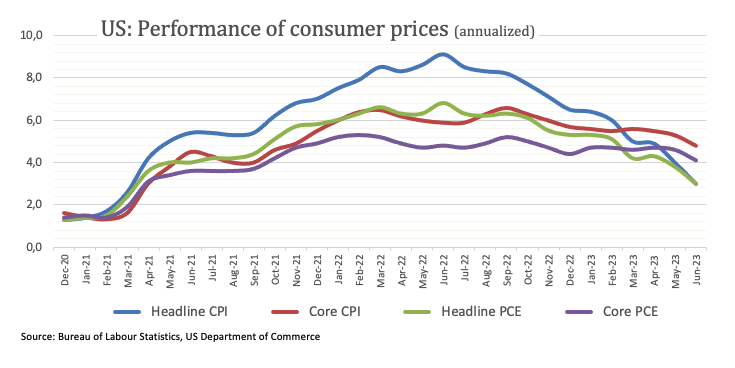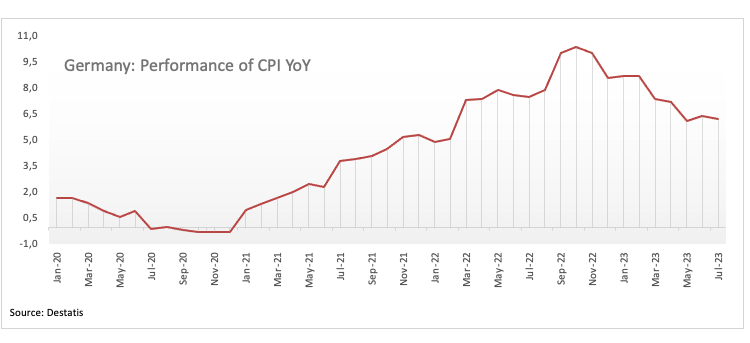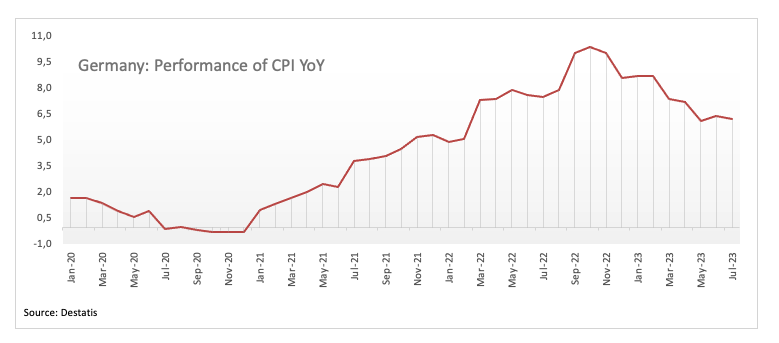Euro maintains the bullish stance above 1.1000
- Euro looks well bid around 1.1000 against the US Dollar.
- Stocks in Europe ended the week mostly on the defensive.
- EUR/USD bounces off three-week lows near 1.0940.
- Advanced CPI in Germany rose 6.2% YoY in July.
- US headline, Core PCE rose at a slower pace in the year to June.
The Euro (EUR) manages to regain composure and leaves behind the earlier pullback to the 1.0940 zone vs. the US Dollar (USD) on Friday, motivating EUR/USD to retake the psychological barrier at 1.1000 the figure and beyond.
The earlier rapid decline in the pair gained momentum as investors were digesting the European Central Bank's (ECB) decision to raise its policy rates by 25 bps on Thursday. The bank's move on rates came together with a dovish message, as the ECB indicated the possibility of a pause in its rate-hiking cycle as early as the September meeting. The ECB also painted a less-optimistic picture regarding the economic outlook for the region.
Still around a potential rate pause, President Christine Lagarde appears to have reinforced this view by suggesting an “open-minded” approach to the September meeting at her press conference on Thursday. She also emphasized that future rate decisions will depend on economic data.
As the Euro regains upside traction, the US Dollar Index (DXY) comes under increasing pressure after climbing to new multi-day highs in the 102.00 neighbourhood. The current corrective decline in the index comes in tandem with further weakness in US yields across across all maturities.
On the domestic front, preliminary GDP figures in Germany indicate a 0.2% YoY contraction in the economy for the April-June period, while advanced inflation figures expect the CPI to have risen 6.2% YoY in July. In the broader euro area, the final Consumer Confidence data matched the initial estimate at -15.1 for the current month.
In the US, inflation figures measured by the PCE rose 3.0% YoY in July and 4.1% when it comes to the Core PCE. Additionally, Personal Income expanded 0.3% MoM, Personal Spending increased 0.5% MoM and Employment Costs-Wages rose 1.0% QoQ in Q2. Further data saw the final Michigan Consumer Sentiment at 71.6 for the current month.

Daily digest market movers: Euro ends the second week in a row with losses
- The EUR extends the rebound past 1.1000 against the USD.
- The USD Index fails to consolidate the earlier breakout of 102.00.
- German flash GDP figures disappointed in the second-quarter.
- US, German yields remain under downside pressure ahead of data.
- Germany's CPI showed prices rose at a slower pace in July.
- US headline, Core PCE suggest the disinflationary pressures remain in place.
- The BoJ surprises everybody after tweaking its yield-curve-control stance.
- ECB’s Simkus, Vasle and others suggested a pause in September is on the table.
- ECB’s SPF sees inflation barely changed in the next three years.
Technical Analysis: Euro could see the 1.0900 zone revisited
The EUR/USD's earlier drop to the 1.0940 region seems to have opened the door to potential extra losses in the short-term horizon.
If bears push harder, EUR/USD should meet immediate contention at the temporary 55-day and 100-day SMAs at 1.0905 and 1.0902, respectively. The loss of this region could open the door to a potential visit to the July 6 low of 1.0833 ahead of the key 200-day SMA at 1.0717 and the May 31 low of 1.0635. South from here emerges the March 15 low of 1.0516 before the 2023 low of 1.0481 on January 6.
On the other hand, occasional bullish attempts could motivate the pair to challenge the 2023 high at 1.1275 recorded on July 18. Once this level is cleared, there are no resistance levels of significance until the 2022 peak of 1.1495 on February 10, which is closely followed by the round level of 1.1500.
The constructive view of EUR/USD appears unchanged as long as the pair trades above the key 200-day SMA.
Euro FAQs
The Euro is the currency for the 20 European Union countries that belong to the Eurozone. It is the second most heavily traded currency in the world behind the US Dollar. In 2022, it accounted for 31% of all foreign exchange transactions, with an average daily turnover of over $2.2 trillion a day.
EUR/USD is the most heavily traded currency pair in the world, accounting for an estimated 30% off all transactions, followed by EUR/JPY (4%), EUR/GBP (3%) and EUR/AUD (2%).
The European Central Bank (ECB) in Frankfurt, Germany, is the reserve bank for the Eurozone. The ECB sets interest rates and manages monetary policy.
The ECB’s primary mandate is to maintain price stability, which means either controlling inflation or stimulating growth. Its primary tool is the raising or lowering of interest rates. Relatively high interest rates – or the expectation of higher rates – will usually benefit the Euro and vice versa.
The ECB Governing Council makes monetary policy decisions at meetings held eight times a year. Decisions are made by heads of the Eurozone national banks and six permanent members, including the President of the ECB, Christine Lagarde.
Eurozone inflation data, measured by the Harmonized Index of Consumer Prices (HICP), is an important econometric for the Euro. If inflation rises more than expected, especially if above the ECB’s 2% target, it obliges the ECB to raise interest rates to bring it back under control.
Relatively high interest rates compared to its counterparts will usually benefit the Euro, as it makes the region more attractive as a place for global investors to park their money.
Data releases gauge the health of the economy and can impact on the Euro. Indicators such as GDP, Manufacturing and Services PMIs, employment, and consumer sentiment surveys can all influence the direction of the single currency.
A strong economy is good for the Euro. Not only does it attract more foreign investment but it may encourage the ECB to put up interest rates, which will directly strengthen the Euro. Otherwise, if economic data is weak, the Euro is likely to fall.
Economic data for the four largest economies in the euro area (Germany, France, Italy and Spain) are especially significant, as they account for 75% of the Eurozone’s economy.
Another significant data release for the Euro is the Trade Balance. This indicator measures the difference between what a country earns from its exports and what it spends on imports over a given period.
If a country produces highly sought after exports then its currency will gain in value purely from the extra demand created from foreign buyers seeking to purchase these goods. Therefore, a positive net Trade Balance strengthens a currency and vice versa for a negative balance.



Comments are closed.